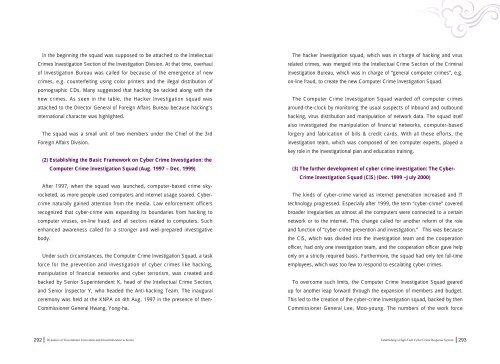Establishing a High-Tech Cyber Crime Response System
Establishing a High-Tech Cyber Crime Response System - Korea.net
Establishing a High-Tech Cyber Crime Response System - Korea.net
- No tags were found...
Create successful ePaper yourself
Turn your PDF publications into a flip-book with our unique Google optimized e-Paper software.
In the beginning the squad was supposed to be attached to the Intellectual<br />
<strong>Crime</strong>s Investigation Section of the Investigation Division. At that time, overhaul<br />
of Investigation Bureau was called for because of the emergence of new<br />
crimes, e.g. counterfeiting using color printers and the illegal distribution of<br />
pornographic CDs. Many suggested that hacking be tackled along with the<br />
new crimes. As seen in the table, the Hacker Investigation squad was<br />
attached to the Director General of Foreign Affairs Bureau because hacking’s<br />
international character was highlighted.<br />
The squad was a small unit of two members under the Chief of the 3rd<br />
Foreign Affairs Division.<br />
(2) <strong>Establishing</strong> the Basic Framework on <strong>Cyber</strong> <strong>Crime</strong> Investigation: the<br />
Computer <strong>Crime</strong> Investigation Squad (Aug. 1997 – Dec. 1999)<br />
After 1997, when the squad was launched, computer-based crime skyrocketed,<br />
as more people used computers and internet usage soared. <strong>Cyber</strong>crime<br />
naturally gained attention from the media. Law enforcement officers<br />
recognized that cyber-crime was expanding its boundaries from hacking to<br />
computer viruses, on-line fraud, and all sectors related to computers. Such<br />
enhanced awareness called for a stronger and well-prepared investigative<br />
body.<br />
Under such circumstances, the Computer <strong>Crime</strong> Investigation Squad, a task<br />
force for the prevention and investigation of cyber crimes like hacking,<br />
manipulation of financial networks and cyber terrorism, was created and<br />
backed by Senior Superintendent K, head of the Intellectual <strong>Crime</strong> Section,<br />
and Senior Inspector Y, who headed the Anti-hacking Team. The inaugural<br />
ceremony was held at the KNPA on 4th Aug. 1997 in the presence of then-<br />
Commissioner General Hwang, Yong-ha.<br />
The hacker Investigation squad, which was in charge of hacking and virus<br />
related crimes, was merged into the Intellectual <strong>Crime</strong> Section of the Criminal<br />
Investigation Bureau, which was in charge of “general computer crimes”, e.g.<br />
on-line fraud, to create the new Computer <strong>Crime</strong> Investigation Squad.<br />
The Computer <strong>Crime</strong> Investigation Squad warded off computer crimes<br />
around-the-clock by monitoring the usual suspects of inbound and outbound<br />
hacking, virus distribution and manipulation of network data. The squad itself<br />
also investigated the manipulation of financial networks, computer-based<br />
forgery and fabrication of bills & credit cards. With all these efforts, the<br />
investigation team, which was composed of ten computer experts, played a<br />
key role in the investigational plan and education training.<br />
(3) The further development of cyber crime investigation: The <strong>Cyber</strong>-<br />
<strong>Crime</strong> Investigation Squad (CIS) (Dec. 1999 –July 2000)<br />
The kinds of cyber-crime varied as internet penetration increased and IT<br />
technology progressed. Especially after 1999, the term “cyber-crime” covered<br />
broader irregularities as almost all the computers were connected to a certain<br />
network or to the internet. This change called for another reform of the role<br />
and function of “cyber-crime prevention and investigation.” This was because<br />
the CIS, which was divided into the investigation team and the cooperation<br />
officer, had only one investigation team, and the cooperation officer gave help<br />
only on a strictly required basis. Furthermore, the squad had only ten full-time<br />
employees, which was too few to respond to escalating cyber crimes.<br />
To overcome such limits, the Computer <strong>Crime</strong> Investigation Squad geared<br />
up for another leap forward through the expansion of members and budget.<br />
This led to the creation of the cyber-crime Investigation squad, backed by then<br />
Commissioner General Lee, Moo-young. The numbers of the work force<br />
292 Dynamics of Government Innovation and Decentralization in Korea<br />
<strong>Establishing</strong> a <strong>High</strong>-<strong>Tech</strong> <strong>Cyber</strong> <strong>Crime</strong> <strong>Response</strong> <strong>System</strong><br />
293
















